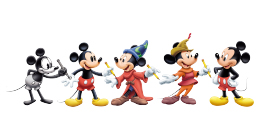Kaitlynn, West Burlington, Iowa
A: Disney has released all of the animated features from Pixar Animation Studios, beginning with Toy Story in 1995; Disney purchased Pixar in 2006. While all the features from Pixar have used computer animation, and have been known as Disney/Pixar films, Walt Disney Animation Studios has done some of its own films using computers, including Chicken Little, Meet the Robinsons, Bolt, Tangled, and Wreck-It Ralph.
Christine, Everett, Massachusetts
A: He does not have a name; he is known as just Beast, or the Prince.
Avi, Irvine, California
A: Composer Richard Sherman consulted with the filmmakers.
Avi, Irvine, California
A: I did rescue a collection of the toy soldiers from the film in searching through a studio-building attic more than 40 years ago. The Treasures of the Walt Disney Archives exhibit at the Ronald Reagan Presidential Library and Museum included Tommy Sands/Tom Piper’s wedding costume and Annette Funicello/Mary Contrary’s red velvet cape. The other items probably did not survive.
Randy, Lithia Springs, Georgia
A: John Grant in his authoritative Encyclopedia of Walt Disney’s Animated Characters, refers to him as a “rogue cat.” According to Grant, this differs from his earliest appearances in the Alice Comedies before his look was changed, where he was “most probably a tail-less rat or oversized mouse.”
Patrick, Marlton, New Jersey
A: If you are referring to the 1979 Muppet Movie, which introduced the song “The Rainbow Connection,” it is available from Amazon.com and elsewhere.
Emily, Celebration, Florida
A: Both spellings were used at the time the film was released in 1946. Usually we go by the spelling on the film itself, but in this case, the other spelling was a lot more common. As you noticed, the Johnny spelling was used on contemporary merchandise and sheet music. So, there really is no definitive answer; Disney used both spellings.
Dana, West Babylon, New York
A: All story ideas for movies have to be submitted through agents.
Kathy, Schenectady, New York
A: These are segments of Disney theatrical cartoons released for home use in 8 mm by Hollywood Film Enterprises. They would cut a cartoon into multiple parts, then put their own title on each part. I can tell you at least that Donald Duck in Ducking Out is from Orphan’s Picnic (1936). These short films have little or no value, as the old film would be brittle, and all of the full cartoons have been released on VHS or DVD.
Chuck, Columbus, Ohio
A: Disney has always been famous for taking care of its old films, when other studios let theirs disintegrate. So, no, there are not any Disney films that have been lost (except for some early Alice Comedies and Oswald cartoons). Thinking ahead, Walt Disney filmed most of his early television shows in color, even though they were being aired in black and white. Sometimes when the shows were later rerun, shown on Disney Channel, or released on videocassette/DVD, color prints were made from the original negatives. It is possible that some of the shows have never had a color print made. I know of no plans to re-release the seasons of the television series on DVD. The 1951 Christmas show has not been released on video or DVD.


